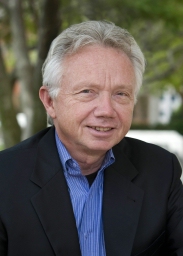Jul 19 2013
Ten years ago, the American Journal of Public Health published a special issue, "Built Environment and Health," that launched a new movement exploring how the physical design of our neighborhoods influences our health.
 Richard Jackson
Richard Jackson
In a new AJPH article, Dr. Richard Jackson, chair of environmental health sciences at UCLA's Fielding School of Public Health, examines what has changed and what lies ahead for the field.
"The past 10 years have witnessed enormous growth in research, teaching and policy related to health and the built environment," said Jackson, a nationally recognized advocate for smarter community design that takes into account issues of public health. "This has become an established field of academic inquiry, sparking multidisciplinary collaboration and a rise in published studies."
Other trends he has observed from the past decade:
- At least 21 universities now offer courses on health and the built environment, and 14 offer joint degrees in urban planning and public health. At UCLA, students may earn a dual master's degree through a partnership between the Fielding School of Public Health and the Luskin School Public Affairs.
- Demographic shifts have fueled interest in livable cities. Driving this trend are members of Generation Y, who tend to prefer mixed-use, walkable neighborhoods and short commutes; childless couples who often favor urban settings; and aging baby boomers who often cannot drive and need access to services.
- Environmental and social campaigns have spurred advances in architecture and urban planning, including at the government level, that promote healthy design. Community planners' use of health-impact assessments, which incorporate health-impact assessments into built-environment decision-making, have reached an all-time high.
Much more needs to be done, according to Jackson, who is also a faculty member at UCLA's David Geffen School of Medicine, Luskin School of Public Affairs, and Institute of the Environment and Sustainability.
"Los Angeles has the finest climate in the world, yet UCLA faculty, staff and students can't easily bike into campus," Jackson noted. "The most outrageous example of poor planning is CalTrans' and Metro's $1 billion-plus upgrade of the Wilshire Boulevard/405 underpass with no cycling capacity. Angelenos deserve protected bike routes connecting Santa Monica, Culver City and Hollywood to the UCLA campus."
He cited Manhattan's waterfront greenway bike path, one of the most heavily used bikeways in the United States, as a prime example of smart city design. "Ten years ago," he said, "this cycling route would have been unthinkable."
Long Beach's efforts to transform itself into a bike-friendly haven are another success story, he added.
Jackson's distinguished career has included serving as head of the National Center for Environmental Health at the Centers for Disease Control and Prevention. He has called attention to the high incidence of asthma, cancer, obesity, diabetes and depression among children and other vulnerable populations living in environments that expose them to harmful contaminants and discourage physical activity.
"We need more research to fully understand how to reap benefits for our neurodevelopment and physical, mental and respiratory health from the built environment," said Jackson, who produced a four-part PBS series on designing healthy communities. "We need to identify the populations most affected by substandard housing and intervene — by translating what we've learned into the creation and operation of cities that foster wellness."
Read more about Jackson and his work on the UCLA Newsroom and in UCLA Magazine and UCLA Today.
The UCLA Fielding School of Public Health is dedicated to enhancing the public's health by conducting innovative research; training future leaders and health professionals; translating research into policy and practice; and serving local, national and international communities.